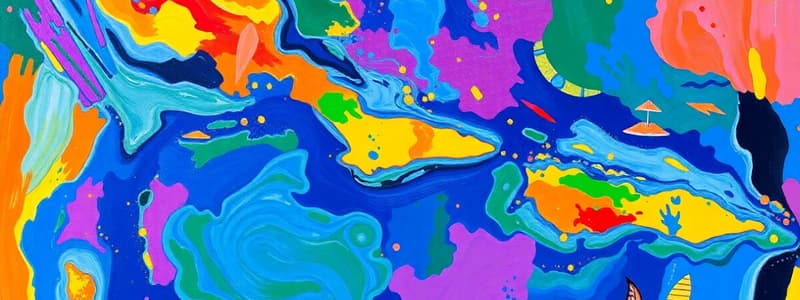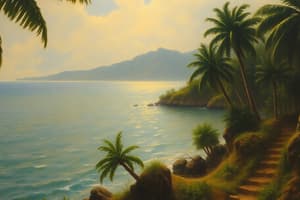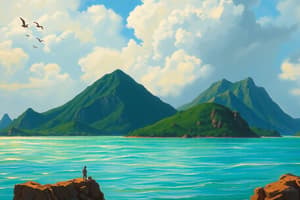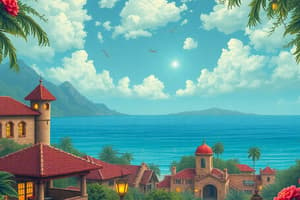Podcast
Questions and Answers
What characterizes the political history of Colombia today?
What characterizes the political history of Colombia today?
- It is a monarchy.
- It is governed by military rulers.
- It is a democracy. (correct)
- It has a totalitarian regime.
What issue is currently significant in Venezuela's political landscape?
What issue is currently significant in Venezuela's political landscape?
- A political crisis. (correct)
- A peaceful transition to democracy.
- Increased military control.
- Rising economic stability.
Which European countries previously ruled Guyana before its independence?
Which European countries previously ruled Guyana before its independence?
- France and Germany.
- Spain and Portugal.
- Italy and Belgium.
- The Dutch and the English. (correct)
What socio-economic challenge does Guyana still face today?
What socio-economic challenge does Guyana still face today?
Which language is commonly spoken in French Guiana?
Which language is commonly spoken in French Guiana?
What cultural traits do Guyana and French Guiana share?
What cultural traits do Guyana and French Guiana share?
What is the predominant language in the Caribbean?
What is the predominant language in the Caribbean?
Which of the following is the largest lake in the Caribbean?
Which of the following is the largest lake in the Caribbean?
What is the highest point in the Caribbean?
What is the highest point in the Caribbean?
Which river holds the title of the largest river in the Caribbean?
Which river holds the title of the largest river in the Caribbean?
Which tribes are considered the native inhabitants of the Caribbean?
Which tribes are considered the native inhabitants of the Caribbean?
What geographical feature connects North America to South America?
What geographical feature connects North America to South America?
Which of the following is NOT a predominant religion in the Caribbean region?
Which of the following is NOT a predominant religion in the Caribbean region?
Which island is NOT one of the three largest islands in the Caribbean?
Which island is NOT one of the three largest islands in the Caribbean?
Which of these characteristics is true about most of the Caribbean islands?
Which of these characteristics is true about most of the Caribbean islands?
What is the largest lake in Central America?
What is the largest lake in Central America?
Which river is considered the longest river in Central America?
Which river is considered the longest river in Central America?
What factor significantly influenced migration patterns in the Caribbean and Central America?
What factor significantly influenced migration patterns in the Caribbean and Central America?
Which mountain range is the longest in Central America?
Which mountain range is the longest in Central America?
Which of the following best describes the Atacama Desert?
Which of the following best describes the Atacama Desert?
Which civilization was conquered by Hernan Cortes?
Which civilization was conquered by Hernan Cortes?
What was a significant result of European colonization in Central America?
What was a significant result of European colonization in Central America?
Which country in Central America is NOT bordered by the Caribbean Sea?
Which country in Central America is NOT bordered by the Caribbean Sea?
What is primarily responsible for the cultural influences in the Caribbean, Central, and South America?
What is primarily responsible for the cultural influences in the Caribbean, Central, and South America?
Which of the following populations is considered a major ethnic group in present-day Mexico?
Which of the following populations is considered a major ethnic group in present-day Mexico?
Flashcards
Caribbean Islands
Caribbean Islands
A group of about 7,000 islands in the Atlantic Ocean, Caribbean Sea, and Gulf of Mexico.
Volcanic Origin
Volcanic Origin
Many Caribbean islands are formed from volcanoes.
Lake Enriquillo
Lake Enriquillo
The largest lake in the Caribbean, located on Hispaniola.
Cauto River
Cauto River
Signup and view all the flashcards
Caribbean Population
Caribbean Population
Signup and view all the flashcards
Dominant Caribbean Language
Dominant Caribbean Language
Signup and view all the flashcards
Dominant Caribbean Religion
Dominant Caribbean Religion
Signup and view all the flashcards
Three Largest Caribbean Islands
Three Largest Caribbean Islands
Signup and view all the flashcards
Isthmus
Isthmus
Signup and view all the flashcards
Central America's Connection
Central America's Connection
Signup and view all the flashcards
What is an isthmus?
What is an isthmus?
Signup and view all the flashcards
Central America's Tallest Point
Central America's Tallest Point
Signup and view all the flashcards
Central America's Longest River
Central America's Longest River
Signup and view all the flashcards
Central America's Largest Lake
Central America's Largest Lake
Signup and view all the flashcards
South America's Size
South America's Size
Signup and view all the flashcards
Amazon's Big Title
Amazon's Big Title
Signup and view all the flashcards
Angel Falls' Height
Angel Falls' Height
Signup and view all the flashcards
Lake Titicaca's Altitude
Lake Titicaca's Altitude
Signup and view all the flashcards
Andes Mountain Distinction
Andes Mountain Distinction
Signup and view all the flashcards
Colombia's Political History
Colombia's Political History
Signup and view all the flashcards
Venezuela's Political History
Venezuela's Political History
Signup and view all the flashcards
Guyana's Cultural Influence
Guyana's Cultural Influence
Signup and view all the flashcards
Guyana's History
Guyana's History
Signup and view all the flashcards
French Guiana's Cultural Influence
French Guiana's Cultural Influence
Signup and view all the flashcards
French Guiana's History
French Guiana's History
Signup and view all the flashcards
Study Notes
Caribbean
- Composed of around 7,000 islands
- Surrounded by the Atlantic Ocean, Caribbean Sea, and Gulf of Mexico.
- Also known as West Indies or the Antilles.
- Primarily volcanic origin, with active volcanoes.
- Three largest islands: Cuba, Jamaica, Hispaniola.
- Lake Enriquillo (largest lake) located on Hispaniola.
- Cauto River (largest river) on Cuba.
- Estimated population: ~36 million.
- Predominant language: Spanish.
- Predominant religion: Catholicism.
- Diverse ancestry: African/Caribbean, European/Caribbean, and Indigenous (Arawak, Caribs, Tainos).
Central America
- Isthmus connecting North and South America.
- Narrow strip of land surrounded by sea.
- Mostly volcanic origin.
- Sierra Madre de Chiapas (longest mountain range).
- Volcán Tajumulco (highest elevation).
- Lake Nicaragua (largest lake).
- Rio Coco (longest river).
- Abundant rainforests.
- Second-largest coral reef in the world.
- Estimated population: ~43 million.
- Predominant language: Spanish, English in Belize.
- Predominant religion: Catholicism.
- "Banana republics": nickname for unstable nations dependent on specific crops/resources.
- Significant indigenous populations before European arrival.
South America
- Fourth-largest continent.
- Contains the Amazon Rainforest (world's largest).
- Amazon River (largest river volume).
- Angel Falls (highest waterfall).
- Andes Mountains (longest mountain range).
- Lake Titicaca (among highest lakes).
- Atacama Desert (driest place on Earth).
- Estimated population: ~380 million.
Migration in the Caribbean, Central America, and South America
- Driven by natural resources and climate.
- European migration: driven by seeking gold, silver, and farmable land (late 1400s).
- European migration had disastrous consequences for native populations (killing, enslaving, forced migration).
- Climate influences population concentration: warmer regions have smaller populations.
- Coastlines attract more people in Central America and the Caribbean.
- South America's population concentrated in more moderate climates (Amazon mouth to Argentina region).
Culture of Caribbean, Central America, and South America
- Deeply influenced by European colonization.
- Mestizos (people of Spanish and Native American descent) prevalent.
- Spanish and English (European languages) commonly spoken.
- Catholicism is a dominant religion.
- Significant African influence in many regions, particularly in Afro-Caribbean.
- Examples include Caribbean indigenous influence and Central America's Mayan culture.
- Pre-colonial cultures are still honored.
Mexico
- Indigenous civilizations (Mayans, Aztecs) preceded European colonization.
- Hernan Cortes conquered the Aztec Empire.
- Tenochtitlan (Aztec capital) replaced by Mexico City (Spanish capital).
- Spanish colonization lasted 300 years, impacting language and religion.
- Mexico lost significant territory in wars with Texas and the United States.
- Divided into 32 states.
- Two main political parties: PRI and PAN.
Caribbean South America
- Composed of Colombia, Venezuela, Guyana, and French Guiana.
- Colombia and Venezuela: Spanish-speaking, Catholic majority, turbulent/democratic political history.
- Venezuela: Current political crisis.
- Guyana and French Guiana: cultural ties to the Caribbean, largely English speaking in Guyana and French speaking in French Guiana, struggling economies, fledgling democracies.
Studying That Suits You
Use AI to generate personalized quizzes and flashcards to suit your learning preferences.




